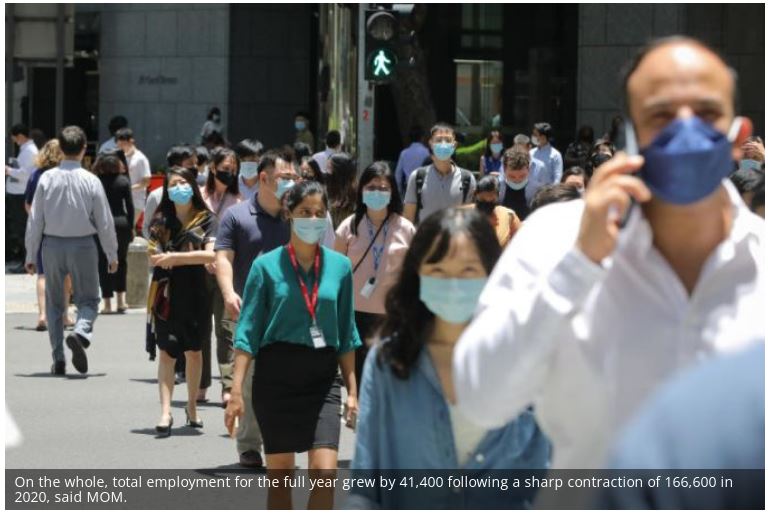Singapore’s non-resident employment rose for the first time in 2 years in Q4
SINGAPORE’S non-resident employment rose for the first time in 2 years in the last quarter of 2021 as border measures gradually eased, though it was still down by 30,000 for the full year, the Ministry of Manpower (MOM) revealed in its latest Labour Market Report on Monday (Mar 14).
Total employment also saw an increase of 47,900 in Q4 after 2 previous quarters of decline.
The labour market is expected to continue improving in 2022, though recent events such as the Russia-Ukraine conflict have “significantly increased the downside risks” which could weigh on the pace of recovery, said permanent secretary Aubeck Kam.
The pace of recovery may also be more gradual as the most significant gains were made in 2021, said MOM.
On the whole, total employment for the full year grew by 41,400 following a sharp contraction of 166,600 in 2020.
MOM attributed the rebound to faster growth in resident employment, which expanded by 71,300 in 2021. This more than offset the 30,000 decline in non-resident employment.
Gains were mostly observed in the following sectors: information and communications; health and social services; professional services; administrative and support services; and financial services.
Meanwhile, resident employment fell moderately in accommodation; air transport and support services; and arts, entertainment and recreation sectors, which MOM said reflected the effects of tight travel restrictions for most part of the year.
The decline in non-resident employment was mainly driven by a fall of 15,300 and 12,200 in Employment Pass (EP) and S Pass holders respectively. Work Permit holders saw a smaller decline of 2,400.
Only construction saw a boost in non-resident employment in the final quarter of the year due to the gradual reopening of Singapore’s borders.
The annual average unemployment rate in 2021 was much lower than in 2020. The average overall unemployment rate fell to 2.7 per cent, from 3 per cent previously; the average resident unemployment rate declined to 3.5 per cent, from 4.1 percent; while the average citizen unemployment rate fell to 3.7 per cent, from 4.2 per cent.
Retrenchment fell to 8,020 in 2021, down from a high of 26,110 in 2020 and below the levels seen before the Covid-19 pandemic.
As business activities picked up, fewer employees were also placed on short work-week arrangements or temporarily laid off by Q4, though the number remains above pre-pandemic levels, said MOM.
“The 6 month re-entry rate for retrenched residents is at a 6-year high,” said Kam. For the full year, the rate of re-entry into employment rose to 66 per cent, up from 62 per cent in the previous year and back to pre-pandemic levels.
The seasonally-adjusted recruitment rate rose to 2.5 per cent in Q4, a rate last seen in 2014, while the seasonally-adjusted resignation rate held steady at 1.7 per cent, just below the typical pre-pandemic rate.
Job vacancies rose to 117,100 in December on a seasonally-adjusted basis, while the ratio of job vacancies to unemployed persons went up to 2.11, from 1.95 in September.
MOM said the high number of job openings was driven in part by travel restrictions impacting the inflow of migrant workers.
The outlook domestically will continue to be uneven, with outward-oriented sectors such as the financial and insurance services and information and communications sector expecting to see growth barring a sharp slowdown in the global economy, said the ministry.
Consumer-facing sectors – such as food and beverage services and retail trade – are also expected to benefit from the gradual easing of Covid-19 measures in Singapore.
However, the recovery is expected to still be slow for the tourism and aviation-related sectors on the account of gradual loosening of travel restrictions globally and the nascent recovery in global travel demand.
Employment levels in these sectors may take longer to return to pre-Covid levels, said MOM.
Source: https://www.businesstimes.com.sg/government-economy/singapores-non-resident-employment-rose-for-the-first-time-in-2-years-in-q4


 Thailand
Thailand




